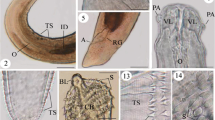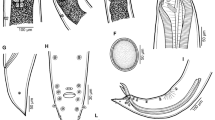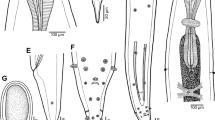Abstract
In the present study, the morphology and morphometric characterization of Dujardinnascaris mujibii (Heterocheilidae) and Hysterothylacium aduncum (Anisakidae), new nematode parasites infecting the sea bream Pagrus pagrus (Osteichthyes, Sparidae), were described for the first time from the Gulf of Suez and Hurghada City of the Red Sea, Egypt. Ninety-eight (70 %) and 62 (44.2 %) out of 140 of the examined fish were naturally infected with these nematodes, respectively. The infection was investigated macroscopically by the occurrence of these parasites in the flesh, stomach, intestines, as well as their body cavities as adult and larval stages. D. mujibii is characterized by an elongated body with a length of 36.4 ± 3 (23–38) mm (female) and 20 ± 3.0 (17–24) mm (males); the head is provided with three prominent lips each with four teeth like structures and the apical lip is embossed with a regular zigzag pattern as revealed by SEM. Interlabia were present, with prominent grooves. Juvenile stage is smaller than adults and provided with a spiny mucron. H. aduncum was small, measured 22.5 ± 2.0 (20.0–24.3) mm in length (female) and 16.3 ± 2.0 (14.5–17.4) mm (male). The head region bears three large lips which were clearly separated from each other, with the apical one having two rounded ends and the space between the two adjacent lips occupied by very prominent interlabia. The present study represents new host and locality records from P. pagrus fish in Egypt.


Similar content being viewed by others
References
Akhtar Y (2008) Feeding habits and nematode parasites of some fishes of Karachi coast. Department of Botany, Jinnah University for Women, Nazimabad, Karachi, Pakistan pp. 268
Amor N, Farjallah S, Merella P, Said K, Slimane B (2011) Molecular characterization of H. aduncum (Nematoda: Raphidascaridae) from different fish caught off the Tunisian coast based on nuclear ribosomal DNA sequences. Parasitol Res 109:1429–1437
Anderson RC (2000) Nematode parasites of vertebrates: their development and transmission. CAB, Wallingford
Arya, Johnson (1978) D. cybii new species from the fish Cybiumguttatum with a key to the Indian species of the genus Dujardinascaris new record nematode. J Vestnick Ceskoslovenske Spolecnosti Zoologicke 42(2):81–84
Baylis HA (1923) Reports on collection of parasitic nematodes mainly from Egypt. Pt.1.Ascarida and Heterakidae; Pt. 11. Oxyuridae; Pt 111 Camallanidae etc. Parasitology 15:1–38
Baylis HA (1947) The nematode genus Dujardinascaris (nom.nov. pro. Dujardinia) in Crocodilia with a description of a new species. Ann Mag Nat Hist 14:123–134
Bilqees FM, Fatima H, Rehana R (1977) Marine fish nematodes of Pakistan. VII. Description of three species including two new nematodes. Pak J Zool 9:167–176
Bilqees FM, Shabbir I, Haseeb MF (2004) D. karachiensis n sp. (Heterocheilidae: Filopsularinae) from the fish Pomadasys olivaceus of Karachi coast. Proc Parasitol 38:63–69
Brizzola SM, Tanzola RD (1995) H. rhamdiae n.sp., (Ascaridoidea: Anisakidae) from a Neotropical catfish, Rhamdia sapo (Pisces: Pimelodidae). Mem’orias do Instituto Oswaldo Cruz 90: 349–352
Bruce NL, Adlard RD, Cannon LRG (1994) synoptic checklist of ascaridoid parasites (Nematoda) from fish hosts. Invertebr Taxon 8:583–674
Carvajal JR, Gonzalez L (1990) Presence of Hysterothylacium sp. (Nematoda: Anisakidae) in a cage-cultured coho salmon in Chile. Rev Chil Hist Nat 63:165–168
Carvajal J, Gonzales L, Toledo G (1995) New records of H. aduncum (Rudolphi, 1802) (Nematoda: Anisakidae) in salmonids cultured in sea farms from Southern Chile. Res Rev Parasitol 55:195–197
Costa G, Pontes T, Mattiucci S, Amelio SD (2003) The occurrence and infection dynamics of Anisakis larvae in the blackscabbard fish, Aphanopus carbo, chub mackerel, Scomber japonicas, and Oceanic horse mackerel, Trachurus picturatus from Madeira, Portugal. J Helminthol 77:163–166
Deardorff TL, Overstreet RM (1981) Review of Hysterothylacium, and Iheringascaris (both previously: Thynnascaris) (Nematoda: Anisakidae) from the northern Gulf of Mexico. Proc Biolog Soc Wash 93:1035–1079
Deardorff TL, Overstreet RM (1982) H. pelagicum sp. n. and H. cornutum (Stossich, 1904) (Nematoda: Anisakidae) from marine fishes. Proc Helminthol Soc Wash 49:246–251
Dollfus RP (1933) Thynnascaris legendrei n.gen., n.sp. de l’estomac du German, Germoalalonge (Gmel). Bull Soc Zool. France 1933(58):7–12
Eiras JC, Rego AA (1987) The histopathology of Scomber japonicus infection by Nematobothrium scombri (Trematoda: Didymozoidae) and of larval anisakid nematode infections in the liver of Pagrus pagrus. Mem Inst Oswaldo Cruz 82:155–159
Genc ER (2002) The endoparasites and histopathologies found in some commercial teleosts in the Bay of Iskenderun. PhD Thesis, Department of Fisheries, Institute of Natural and Applied Sciences, Adana,Turkey. University of Cukurova
Genc ER, Genc AM, Genc EV, Cengizler I, Can FM (2005) Seasonal variation and pathology associated with helminthes infecting two serranids (Teleostei) of Iskenderun Bay (Northeast Mediterranean Sea), Turkey. Turkish J Fish Aqua Sci 5:29–33
Gonzales L, Carvajal J (1994) Parasitos en los cultivos marinos de salmónidos en el Sur del Chile. Ivest Pesqueras 38:87–96
González L (1998) The life cycle of H. aduncum (Nematoda: Anisakidae) in Chilean marine farms. Aquaculture 162:173–186
Hafesteinsson H, Rizvi SS (1987) A review of the sealworm problem: biology, implications and solutions. J Food Prot 50:70–84
Hoffman GL (1970) Parasite of North American fresh water fishes. University of California Press, Berkeley, p 480
Khan D, Begum A (1971) Helminth parasites of fishes from West Pakistan I. Nematodes. Bull Depart Zool Punjab Univ 5:1–22
Klimpel S, Abdel-Ghaffar F, Al-Rasheid KA, Aksu G, Fischer K, Strassen B, Mehlhorn H (2011) The effects of different plant extracts on nematodes. Parasitol Res 108(4):1047–1054
Køie M (1993) Aspects of the life-cycle and morphology of H. aduncum (Rudolphi, 1802) (Nematoda, Ascaridoidea, Anisakidae). Can J Zool 71:1289–1296
Li L, Xu Z, Zhang L (2007) A new species of genus Hysterothylacium Ward et Magath, 1917 (Nematoda, Anisakidae) from Liparis tanakae (Scorpaeniformes, Liparidae) from the Yellow Sea, China. Acta Parasitologica 52(4):371–375
Li L, Liu Y, Zhang L (2012) Morphological and genetic characterization of H. zhoushanensis sp. nov. (Ascaridida: Anisakidae) from the flatfish Pseudorhombus oligodon (Bleeker) (Pleuronectiformes: Paralichthyidae) in the East China Sea. Parasitol Res. doi: 10.1007/s00436-012-3095-3 (in press)
Luo DM (1999) A new species of genus Contracaecum (Ascarididea: Heterocheilidae): C. muraenesoxin sp. nov. and study on its morphological variation. Acta Parasitol Med Entomol Sinica 6:215–222
Machida M, Takahashi K, Masuuchi S (1978) Thynnascaris haze n. sp. (Nematoda, Anisakidae) from goby in the Bay of Tokyo. Bull Nat Sci Museum Ser A (Zoology) 4:241–244
Margolis L (1977) Public health aspects of “Cod worm” infection: a review. J fish Res Board Can 199:1–269
McCarthy J, Moore TA (2000) Emerging helminth zoonoses. Int J Parasitol 30:1351–1360
Mehlhorn H, Al-Quraishy S, Al-Rasheid KA, Jatzlau A, Abdel-Ghaffar F (2011) Addition of a combination of onion (Allium cepa) and coconut (Cocos nucifera) to food of sheep stops gastrointestinal helminthic infections. Parasitol Res 108(4):1041–1046
Moravec F, Vivas-Rodr’iguez C, Scholz T, Vargas-V’azquez J, Mendoza-Franco E (1995) Nematodes parasitic in fishes of cenotes (sinkholes) of the Peninsula of Yucatan, Mexico. Part1. Adults. Folia Parasitol 42:115–129
Morsy K, Bashtar AR, Abdel-Ghaffar F, Mehlhorn H, Quraishy SA, El-Mahdi M, Al-Ghamdi A, Mostafa N (2012) First record of anisakid juveniles (Nematoda) in the European seabass Dicentrarchus labrax (Family: Moronidae), and their role as bio-indicators of heavy metal pollution. Parasitol Res 110(3):1131–1138
Moser M, Hsieh J (1992) Biological tags for stock separation in Pacific herring Clupea harengus pallasi in California. J Parasitol 78:54–60
Navone GT, Sardella NH, Timi JT (1998) Larvae and adults of H. aduncum (Rudolphi, 1802) (Nematoda: Anisakidae) in fishes and crustaceans in the South West Atlantic. Parasite 5:127–136
Norris DE, Overstreet RM (1976) The public health implications of larval Thynnascaris nematodes from shellfish. Milk Food Technol 39:47–54
Overstreet RM, Meyer GW (1981) Hemorrhagic lesion in stomach of rhesus monkey caused by a piscine ascaridoid nematode. J Parasitol 67(2):226–235
Pan JH, Zhang JY, Li CM (1990) Fish parasitology. Beijing Science, Beijing, pp. 291–335
Paperna I (1980) Parasites infections and diseases of fish of Africa, Committee for Inland Fisheries of Africa. CIFAT Technical papers, pp. 51–62
Pearse AS (1936) Parasites from Yucatan. Publ Carneg Inst Wash 457:45–49
Petter AJ, Cabaret J (1995) Ascaridoid nematodes of teleostean fishes from the eastern North Atlantic and seas of the North of Europe. Parasite 2:217–230
Petter AJ, Maillard C (1988) Larves d’ascarides parasites de poissons en Méditerranée occidentale. Bull Mus Natl Hist Nat Paris Ser 10A:347–369
Petter AJ, Radujkovic BM (1989) Parasites des poissonsmarins du Montenegro: nematodes. Acta Adriatica 30:195–236
Railliet A, Henry A (1905) Un nouveau sclerotomien (Triodontophorus deminutus Nov. sp.) parasite de’I’ homme. CR Soc Biol 58:569–571
Railliet A, Henry A (1912) Parasitic nematodes du generacamallanus. Buf Soc Pathol 8:270
Rudolphi CA (1802) Fortsetzung der Beobachtungen uber die Eingeweidewurmer. Arch Zool U Zoot 2:65
Sey O, Petter AJ (1997) Incidence of ascaridoid larvae in Kuwaiti food fishes. Southeast Asian J Trop Med Puplic Health 1:168–172
Shih HH, Jeng MS (2002) H. aduncum (Nematoda: Anisakidae) infecting a herbivorous fish, Siganus fuscescens, off the Taiwanese Coast of the Northwest Pacific. Zoological Studies 41(2):208–215
Smrzlić IV, Valić D, Kapetanović D., Kurtović B, Teskeredžić E (2012) Molecular characterisation of Anisakidae larvae from fish in Adriatic Sea. Parasitol Res. doi: 10.1007/s00436-012-3094-4
Sood ML (1989) Fish nematodes from South Asia. Kalyani, NewDelhi, pp. 704
Thompson RCA (2001) The future impact of societal and cultural factors on parasitic disease—some emerging issues. Int J Parasitol 31:949–959
Ubeira FM, Valinas, B, Lorenzo S, Iglesias R, Figueiras A, Villaescusa R (2000) anisaquiosis y alergia. Un studio soroepidemiológico en la Comunidad Autónoma Gallega. Documentos técnicos de Salud Pública, Serie B, no 24. Ed. Consellería de Sanidade e Servicios Sociais (Xunta de Galicia, España), p. 102
Valero A, López-Cuello MM, Benítez R, Adroher FJ (2006a) Anisakis spp. in European hake, Merluccius merluccius (L.) from the Atlantic off north-west Africa and the Mediterranean off Southern Spain. Acta Parasitol 51:209–212
Valero A, Paniagua MI, Hierro I, Valderrama MJ, Benítez R, Adroher FJ (2006b) anisakid parasites of two forkbeards (Phycis blennoides and P. phycis) from the Mediterranean coast of Andalucía (Southern Spain). Parasitol Int 55:1–5
Vidal-Martínez VM, Osorio-Sarabia D, Overstreet RM (1994) Experimental infection of C. multipapilatum (Nematoda: Anisakinae) from Mexico in the domestic cat. J Parasitol 80:576–579
Yamaguti S (1941) Studies on the helminth fauna of Japan. Part II. Nematodes of fishes. Jpn J Zool 9:343–396
Yoshinaga T, Ogawa K, Wakabayashi H (1987a) Experimental life cycle of H. aduncum (Nematoda: Anisakidae) in fresh water. Fish Pathol 22:243–251
Yoshinaga T, Ogawa K, Wakabayashi H (1987b) New record of third-stage larvae of H. aduncum (Nematoda: Anisakidae) from Neomysis intermedia (Crustacea: Mysidae) in a freshwater lake in Hokkaido. Jap Nippon Suisan Gakkai 53:63–65
Yoshinaga T, Ogawa K, Wakabayashi H (1989) Life cycle of Hysterothylacium haze (Nematoda: Anisakidae: Raphidascaridinae). J Parasitol 75(5):756–763
Zaidi DA, Khan D (1975) Nematode parasites from fishes of Pakistan. Pakistan J Zool 7:51–73
Zubari HB, Farooq M (1976) D. qadrii n. sp. a new nematode from the intestine of a marine fish Sciaena sp. from Pakistan. Pakistan J Zool 8(1):73–76
Acknowledgments
The authors would like to thank Prof. Dr. Heinz Mehlhorn, Parasitology Institute, Dusseldorf University, Germany for his critical reading of the manuscript.
Author information
Authors and Affiliations
Corresponding author
Rights and permissions
About this article
Cite this article
Morsy, K., Bashtar, AR., Abdel-Ghaffar, F. et al. New host and locality records of two nematode parasites Dujardinnascaris mujibii (Heterocheilidae) and Hysterothylacium aduncum (Anisakidae) from the common seabream Pagrus pagrus: a light and scanning electron microscopic study. Parasitol Res 112, 807–815 (2013). https://doi.org/10.1007/s00436-012-3270-6
Received:
Accepted:
Published:
Issue Date:
DOI: https://doi.org/10.1007/s00436-012-3270-6




